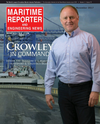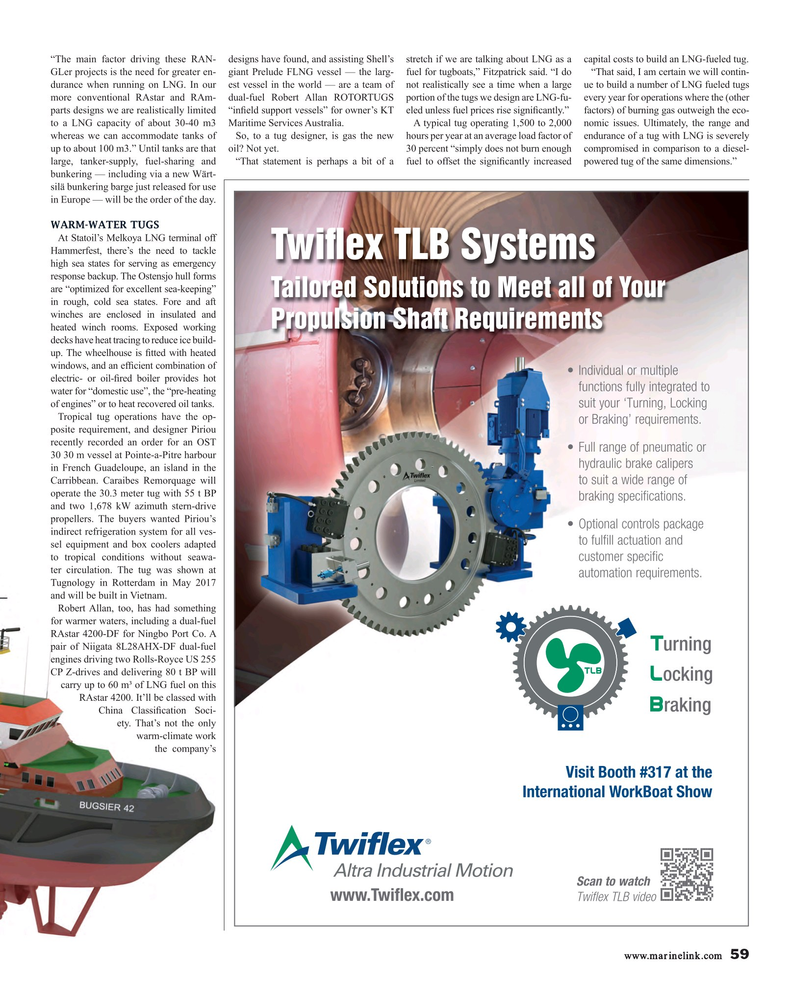
Page 59: of Maritime Reporter Magazine (November 2017)
The Workboat Edition
Read this page in Pdf, Flash or Html5 edition of November 2017 Maritime Reporter Magazine
“The main factor driving these RAN- designs have found, and assisting Shell’s stretch if we are talking about LNG as a capital costs to build an LNG-fueled tug.
GLer projects is the need for greater en- giant Prelude FLNG vessel — the larg- fuel for tugboats,” Fitzpatrick said. “I do “That said, I am certain we will contin- durance when running on LNG. In our est vessel in the world — are a team of not realistically see a time when a large ue to build a number of LNG fueled tugs more conventional RAstar and RAm- dual-fuel Robert Allan ROTORTUGS portion of the tugs we design are LNG-fu- every year for operations where the (other parts designs we are realistically limited “in? eld support vessels” for owner’s KT eled unless fuel prices rise signi? cantly.” factors) of burning gas outweigh the eco- to a LNG capacity of about 30-40 m3 Maritime Services Australia. A typical tug operating 1,500 to 2,000 nomic issues. Ultimately, the range and whereas we can accommodate tanks of So, to a tug designer, is gas the new hours per year at an average load factor of endurance of a tug with LNG is severely up to about 100 m3.” Until tanks are that oil? Not yet. 30 percent “simply does not burn enough compromised in comparison to a diesel- large, tanker-supply, fuel-sharing and “That statement is perhaps a bit of a fuel to offset the signi? cantly increased powered tug of the same dimensions.” bunkering — including via a new Wärt- silä bunkering barge just released for use in Europe — will be the order of the day.
WARM-WATER TUGS
At Statoil’s Melkoya LNG terminal off
Hammerfest, there’s the need to tackle
Twifex TLB Systems high sea states for serving as emergency response backup. The Ostensjo hull forms are “optimized for excellent sea-keeping”
Tailored Solutions to Meet all of Your in rough, cold sea states. Fore and aft winches are enclosed in insulated and
Propulsion Shaft Requirements heated winch rooms. Exposed working decks have heat tracing to reduce ice build- up. The wheelhouse is ? tted with heated windows, and an ef? cient combination of • Individual or multiple electric- or oil-? red boiler provides hot functions fully integrated to water for “domestic use”, the “pre-heating of engines” or to heat recovered oil tanks. suit your ‘Turning, Locking
Tropical tug operations have the op- or Braking’ requirements.
posite requirement, and designer Piriou recently recorded an order for an OST • Full range of pneumatic or 30 30 m vessel at Pointe-a-Pitre harbour hydraulic brake calipers in French Guadeloupe, an island in the
Carribbean. Caraibes Remorquage will to suit a wide range of operate the 30.3 meter tug with 55 t BP braking specifications.
and two 1,678 kW azimuth stern-drive propellers. The buyers wanted Piriou’s • Optional controls package indirect refrigeration system for all ves- to fulfill actuation and sel equipment and box coolers adapted to tropical conditions without seawa- customer specific ter circulation. The tug was shown at automation requirements.
Tugnology in Rotterdam in May 2017 and will be built in Vietnam.
Robert Allan, too, has had something for warmer waters, including a dual-fuel
RAstar 4200-DF for Ningbo Port Co. A pair of Niigata 8L28AHX-DF dual-fuel engines driving two Rolls-Royce US 255
CP Z-drives and delivering 80 t BP will carry up to 60 m³ of LNG fuel on this
RAstar 4200. It’ll be classed with
China Classi? cation Soci- ety. That’s not the only warm-climate work the company’s
Visit Booth #317 at the
International WorkBoat Show
Scan to watch www.Twifex.com
Twiflex TLB video www.marinelink.com 59
MR #11 (58-65).indd 59 MR #11 (58-65).indd 59 11/5/2017 12:29:26 PM11/5/2017 12:29:26 PM

 58
58

 60
60
